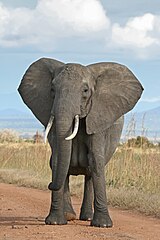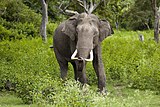This is a list of all nine extant species of megaherbivores, with a brief description for each. Elephants, rhinoceroses, hippopotamuses, and giraffes are all included in this list. They are ordered in descending order, from the largest species to the smallest.[1]
List
| Common name | Image | Description |
|---|---|---|
| African bush elephant (Loxodonta africana) |  | The African bush elephant, also known as the Savanna elephant is one of three members of the family Elephantidae, in which it is the largest member.[2] They are native to a large part of sub-Saharan Africa.[3] They are characterized by their by their large size, huge ears, long trunk with two finger-like processes and large ivory tusks.[4]: 124 [5] |
| Asian elephant (Elephas maximus) |  | The Asian elephant also known as the Asiatic elephant is the second largest elephant species native to the Indian subcontinent and Southeast Asia.[6] Its back is convex and its ears are relatively small compared to African elephants. The trunk has one finger-like processing and contains over 60,000 muscles and males are the ones who often grow tusks.[7] |
| African forest elephant (Loxodonta cyclotis) |  | The African forest elephant is the smallest species of elephants. It is native to West Africa and the Congo Basin. It is one of two species of African elephants, the other being the African bush elephant.[8] Its trunk has two finger-like processes and contains about 40–60,000 muscles.[9] It has tusks that grow to 1.5 m (4 ft 11 in) long and weigh 23–45 kg (51–99 lb).[10] |
| White rhinoceros (Ceratotherium simum) |  | The white rhinoceros sometimes called the white rhino or square-lipped rhinoceros is a large rhinoceros native to sub-Saharan Africa.[11] The largest extant rhino species, it has two horns with the front horn growing up to 101 cm (40 in).[12]: 31 It has a visible hump on the back of the neck. Despite their size they can run at speeds of 50 km/h (31 mph).[13] |
| Indian rhinoceros (Rhinoceros unicornis) |  | The Indian rhinoceros also known as the Indian rhino, greater one-horned rhinoceros or great Indian rhinoceros, is the second largest extant rhinoceros native to the Indian subcontinent.[14] It has one horn that grows to a length of about 25 cm (9.8 in).[15]: 59–61 It is the second largest land mammal native to Asia, after the Asian elephant.[16][17] |
| Hippopotamus (Hippopotamus amphibius) |  | The hippopotamus also known as the hippo, common hippopotamus or river hippopotamus is a large mammal native to sub-Saharan Africa. It is semiaquatic and spends most of its time resting in water.[18] They have large canines up to 50 cm (20 in) long and their incisors can grow to 40 cm (16 in).[19]: 222 They have large barrel-shaped torsos, with pillar-like legs and nearly hairless bodies. They can run at 30 km/h (19 mph) in spite of their size.[20] |
| Black rhinoceros (Diceros bicornis) |  | The black rhinoceros also called the black rhino or hook-lipped rhinoceros, is a species of rhinoceros native to Southern and East Africa. It has two horns made of keratin, with the larger front horn growing up to 140 cm (55 in). It is actually brown or grey rather than black.[21][22] |
| Javan rhinoceros (Rhinoceros sondaicus) |  | The Javan rhinoceros, Javan rhino, Sunda rhinoceros or lesser one-horned rhinoceros, is a very rare rhinoceros species. With only 74 individuals left, it is critically endangered and only survives in one place, the Ujung Kulon National Park in western Java.[23] Only bulls have horns that grow up to 27 cm (11 in).[24] |
| Giraffe (Giraffa camelopardalis) |  | The giraffe is a large ruminant native to sub-Saharan Africa.[25] It is the tallest terrestrial animal and has an extremely long neck and legs. The neck can grow up to 2.4 m (7 ft 10 in).[26] Male and female giraffes both have horn-like structures called ossicones, which in males can reach 13.5 cm (5.3 in).[27] |
References
🔥 Top keywords: Main PageSpecial:SearchIndian Premier LeagueWikipedia:Featured picturesPornhubUEFA Champions League2024 Indian Premier LeagueFallout (American TV series)Jontay PorterXXXTentacionAmar Singh ChamkilaFallout (series)Cloud seedingReal Madrid CFCleopatraRama NavamiRichard GaddDeaths in 2024Civil War (film)Shōgun (2024 miniseries)2024 Indian general electionJennifer PanO. J. SimpsonElla PurnellBaby ReindeerCaitlin ClarkLaverne CoxXXX (film series)Facebook2023–24 UEFA Champions LeagueYouTubeCandidates Tournament 2024InstagramList of European Cup and UEFA Champions League finalsJude BellinghamMichael Porter Jr.Andriy LuninCarlo AncelottiBade Miyan Chote Miyan (2024 film)